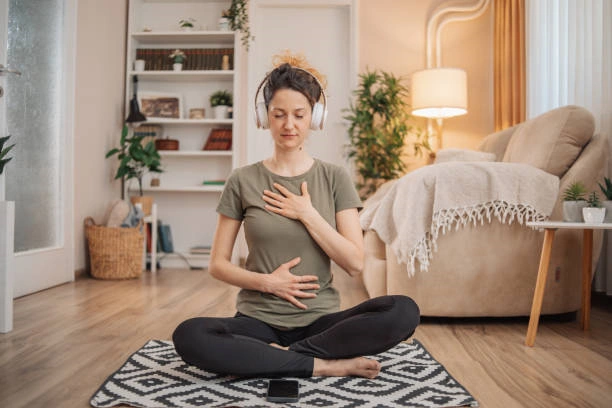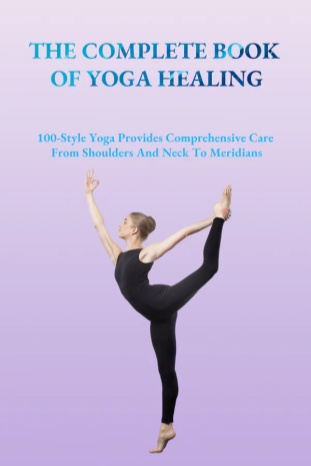Calm Sleep and a Focused Mind—Sleep Meditation Practice
Before going to bed, make sure you’ve done your usual nighttime routine—use the bathroom, lock the doors, turn off your phone, and handle anything else you normally do before sleeping. You can even prepare for the next day or jot down a to-do list for tomorrow. Once ready, lie down on your back as if you’re going to sleep. To feel more comfortable, you can place a thin pillow under your head. If you usually sleep on your stomach or side, that’s fine, but this practice works best when done lying on your back. You can switch to your preferred sleeping position afterward. As you lie there, take a moment to feel your body sinking into the bed, supported by the mattress. Acknowledge that your day is done, and there’s nothing left for you to do. Once you feel settled, take five deep breaths, inhaling through your nose and exhaling through your mouth. While inhaling, feel your lungs expand, and as you exhale, imagine the day’s thoughts and worries fading away. This will help relax both your body and mind for the meditation ahead.

Step 1: Tune into How You Feel
Begin by “checking in” with yourself—notice how your body and mind feel, both physically and mentally. Just as relaxing requires time, so does falling asleep, so take your time during this part of the practice. If you have many thoughts running through your mind (which is perfectly normal), don’t worry, and allow them to be there. Whatever thoughts you have, no matter how unsettling or uncomfortable, avoid resisting them.
Next, focus on the points where your body makes contact with the bed. Bring your attention back to the sensation of your body sinking into the mattress, noticing the areas where the contact feels strongest. Is your weight evenly distributed? You may also notice any sounds or other sensations around you, as noise can sometimes be particularly bothersome when you’re trying to sleep. Start by identifying whether these sounds are something you can control or not. Then, instead of resisting the sounds, gently focus on them for about 30 seconds before returning your attention to your body.
Now, tune in to how your body feels as a whole—does it feel heavy or light, restless or calm? Then, more precisely, scan your body from head to toe, gently noticing any tension or discomfort. It’s natural for your attention to be drawn to areas of tension, but remind yourself that this practice will help ease those tensions. You can relax. You can repeat this body scan several times, each lasting about 30 seconds. Remember to also pay attention to areas of your body that feel relaxed and comfortable.
By now, you’ve likely noticed the rise and fall of your breath, but if you haven’t, shift your attention to where you feel this movement most clearly. As always, avoid trying to control your breath—just let it flow naturally. In this sleep meditation, there is no right or wrong way to breathe. Simply observe whether your breath is deep or shallow, long or short, smooth or irregular. You don’t need to make any effort; just notice your body’s natural movement as you breathe. If your breath feels too faint to detect, placing a hand on your chest or belly may help you feel the rise and fall more clearly. After observing your breath for 1-2 minutes, your mind may wander, which is perfectly normal. When you notice this, gently bring your focus back to your breathing. There’s no need to time this part of the practice—just move on to the next step when it feels right.

Step 2: Review Your Day with Focus
Now, mentally review your day in a focused, orderly way, starting from the moment you woke up. Can you remember how you felt upon waking? Just as if you’ve pressed a gentle “fast forward” button in your mind, replay the events of the day—meetings, conversations, and tasks you completed. This doesn’t need to be detailed, more like an overview or a series of brief snapshots. For example, you might recall turning off your alarm, getting out of bed, showering, having breakfast, walking to work, or greeting a colleague. Spend about 3 minutes mentally reviewing your day until you reach the present moment. Although it might seem difficult to cover so much in just a few minutes, it’s just a quick overview. After a few days of practice, you’ll feel more comfortable with the pace.
As you mentally review your day, you may feel tempted to dwell on certain moments—perhaps a productive meeting makes you start thinking about all the possibilities, or an argument with a colleague brings up worries about its consequences. At night, however, dwelling on these events won’t change anything. So, as soon as you realize your mind has wandered, gently bring your focus back to the “movie” of your day and pick up where you left off.
Step 3: Shift Focus Back to Your Body
Bring yourself back to the present moment and shift your focus back to your body. Start by focusing on your left little toe, imagining that you’re “turning off” each part of your body, preparing it for sleep. As you focus on each part, you might mentally repeat words like “off” or “rest.” This step is like granting your muscles, joints, and body parts permission to rest, knowing you won’t need them again until the morning. Move from each toe to your foot, ankle, and all the way up to your hips. Take a moment to notice the difference between the leg you’ve relaxed and the one you haven’t yet.
Once you’ve relaxed your left leg, repeat the process for your right leg, starting from your toes and moving upward to your waist. Continue this practice, moving up through your torso, then down through each arm and hand, and finally to your neck, face, and head. Take a moment to enjoy the sensation of being free from tension, no longer needing to control any part of your body. Let it rest.

Step 4: Let Go and Embrace Creativity
If you’re still awake after completing these steps, don’t worry—this doesn’t mean you did anything wrong. Remember, the goal of this meditation is not to force sleep but to enhance your awareness of your mind and body as you wind down. At this point, you have two options: allow your mind to wander freely without trying to control it, or count backward from 1000 to 0. Counting backward helps keep your mind busy and focused as you drift off. If your mind wanders, gently return to where you left off and continue counting. One important tip: take this exercise sincerely, aiming to count all the way to 0, but don’t force yourself to fall asleep. Your goal is simply to stay focused as your body and mind gradually shut down. If you fall asleep before reaching 0, that’s perfectly fine.







